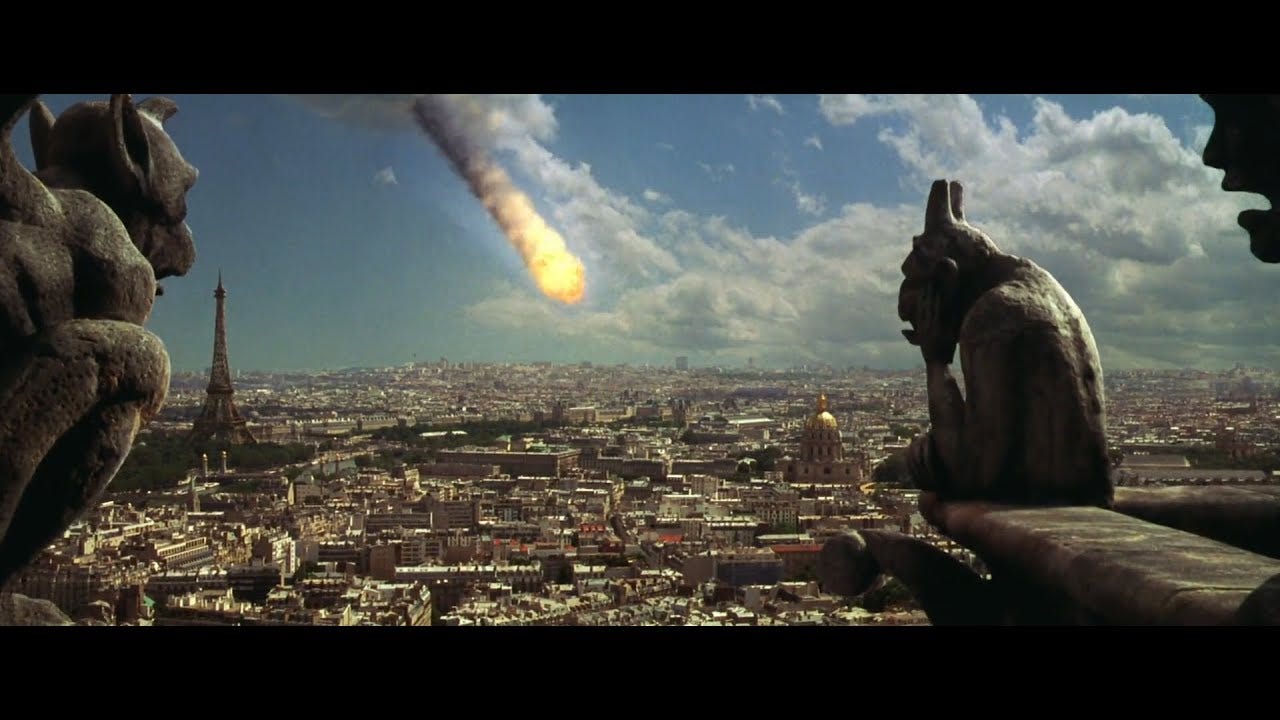🔥 Burn it down
Apologies to Billy Joel. We did start this fire.
This week’s rebroadcast brings together two posts thinking about destruction, when you need it, and how much you can get away with.

You wouldn’t splash gasoline on the walls of your home, then toss a few matches while strolling out the door. In real life, this kind of willful destruction is criminal.
In fiction, it’s crucial.
As the writer, you need to burn down houses. You need to push characters out of their safe places into the big scary world — and make sure they can never get back. Sure, their stated quest might be to get home, but your job is to make sure that wherever they end up is a new and different place.
Writers tend towards benevolence. We love our characters, and want to see them thrive. So it can be hard to accept that what our hero actually needs is to have everything taken away, be it by fire, flood, divorce or zombie uprising. No matter the story, no matter the genre, we need to find ways to strip characters of their insulating bubbles of normalcy.
The Fire (or other catastrophe) often occurs as an inciting incident, setting the wheels of plot in motion. In The House Bunny, Anna Faris’s character is kicked out of the Playboy Mansion by page 10. In Gladiator, Russell Crowe’s family is killed.
Just as often, The Fire signals the end of the first act. In Star Wars, Luke returns home to find his aunt and uncle dead. In 9 to 5, the trio of secretaries has inadvertently kidnapped their boss. There’s no going back to the way things were.
But The Fire can work just as well later in the story, effectively burning bridges characters have just crossed. Three of my upcoming projects feature second-act or third-act Fires that not only keep the momentum going, but also remind the audience of the scale and stakes.1 Late fires ward off complacency in everything from The Dark Knight to Revenge of the Nerds.
It’s easy to think of dozens of great movies that never really burn the house down. But the better exercise is to look at your own scripts and ask, (a) what could burn, and (b) why haven’t I lit it on fire?
Armageddon is bad. Near-Armageddon? Damn Entertaining.
I’m doing research for a movie I may be writing soon, which involves a Very Bad Thing happening to the planet, and its aftermath. You’d think it would be hard to find scholarly (i.e. non-religious) books on the subject, but it’s not. Go into any bookstore and you find whole shelves of hardcovers that chart with considerable detail just how the world will end. Call it Pessimism Porn.
These doom-saying books tend to be bleak. What’s interesting is that movies based on the same ideas tend to have one extra element: hope.
Consider War of the Worlds, or Armageddon, or The Day After Tomorrow. In all three, Very Bad Things happen to the good people of Earth. Cities are destroyed; people are vaporized. Just like we seem hard-wired to love puppies and fear snakes, we want to see the Eiffel tower melt.
For up to 100 minutes of a movie, the entire world and everyone on it can be blown to smithereens. Even in a PG-13 movie, things can get really, really bleak — as long as by the end, things are okay again. Even Deep Impact, which had the guts to actually let the comet hit, still found ways to reassure us that civilization would bounce right back.
Just like a roller-coaster ride, we want the world to spin deliriously out of control, before coming to a safe landing right where we started. Whee! That was fun. Let’s do it again.
Anyone who has read the aforementioned Pessimism Porn recognizes the danger of these movies: most of the things that would destroy us can’t be solved by a courageous hero, a team of dedicated scientists, or a whiz-kid hacker who got beat up in school. Just like we’re more likely to die of heart disease than terrorism, the Very Bad Things that may do us in as a planet tend to be quiet and slow.
So that’s what I’m wrestling with as I think about this movie I may or may not write. How do you dramatize a situation that in real life would end pretty bleakly, but still make a movie that people want to see on a Friday night?
Anyway. I’m thankful to have a job that lets me think about stuff like that.
Are you enjoying this newsletter?
📧 Forward it to a friend and suggest they check it out.
🔗 Share a link to this post on social media.
🗣 Have ideas for future topics (or just want to say hello)? Reach out to Chris via email at inneresting@johnaugust.com, Mastodon @ccsont@mastodon.art, or Threads @ccsont@threads.net
There’s something uniquely cinematic about destroying a giant set. A TV show, no matter its ambitions, generally has to protect its standing sets until at least the end of a season.

